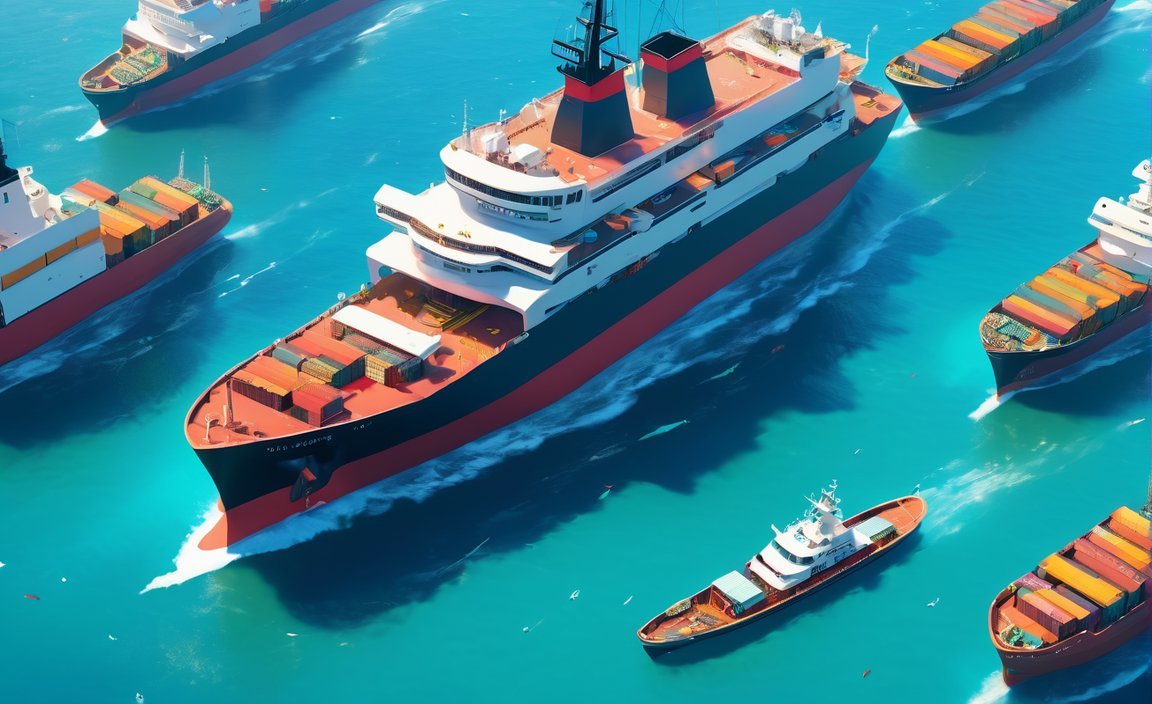Discover the dynamic world of sea transport and unveil its pros and cons in this insightful article on the “Pros and Cons of Sea Transport: Cost-effectiveness, Global Reach, and Challenges.” As we delve into the advantages and disadvantages of water transportation, we will explore the cost-effectiveness, reduced carbon footprint, and global reach that makes sea transport a favored choice in logistics and international trade. However, we will also tackle the challenges it presents, including lengthy transit times, potential cargo damage, and limited accessibility to landlocked regions. Join us in this exploration of sea transport and gain a comprehensive understanding of its intricacies.
Key Takeaways:
Advantages of Sea Transport:
1. Less maintenance cost compared to rail and road transport, making it cost-effective.
2. Sea freight is generally more affordable, especially for long-distance shipments.
3. Ideal for transporting large, heavy, or bulky goods.
4. Can be a reliable choice during natural disasters or other disruptions in land transportation networks.
5. Plays a vital role in defense strategies, offering efficient movement of military equipment and personnel.
Disadvantages of Sea Transport:
1. Generally slower compared to other modes of transport, not suitable for time-sensitive shipments.
2. Subject to weather conditions, which may cause delays or disruptions.
3. May not be suitable for landlocked countries or regions without a well-developed port infrastructure.
4. Risk of loss or damage to goods during transit, although accidents are rare.
5. Contributes to pollution and carbon emissions, with environmental implications.
These key takeaways provide an understanding of the advantages and disadvantages associated with sea transport in international trade. It is important for businesses to consider these factors and assess their specific shipping needs when making transportation choices.
Advantages and Disadvantages of Sea Transport for International Trade

Sea transport plays a crucial role in international trade, offering various advantages and disadvantages. Understanding these factors is essential for businesses to make informed decisions when it comes to shipping goods by sea. In this article, we will delve into the advantages and disadvantages of sea transport in international trade, highlighting the key points to consider.
Advantages of Sea Transport
Sea transport brings several advantages, making it an attractive option for businesses involved in international trade. Let’s take a closer look at these advantages:
Less Maintenance Cost: When compared to rail and road transport, sea transport incurs lower maintenance costs. This cost-effectiveness makes it an appealing option for businesses looking to optimize their transportation expenses.
Affordability: Sea freight tends to be more affordable than other modes of transport, especially for long-distance shipments. This cost advantage can significantly benefit businesses, especially those involved in bulk trading.
Suitability for Bulky Goods: Sea transport is ideal for the transportation of large, heavy, or bulky goods. Unlike other modes of transport, sea vessels can accommodate such cargo without any logistical limitations or challenges.
Resilience During Natural Calamities: Sea transport can be a reliable choice during natural calamities or disruptions in land transportation networks. By leveraging sea routes, businesses can maintain a steady flow of goods, even in the face of adverse weather conditions or other unforeseen events.
Usefulness in Defense: Sea transport plays a vital role in defense strategies. It offers the ability to efficiently move military equipment and personnel, ensuring national security and strategic operations.
Disadvantages of Sea Transport
While sea transport has significant advantages, it also presents certain challenges and disadvantages. Let’s explore these factors:
Slowest Mode of Transport: Sea transport is generally slower compared to other modes of transport like air or rail. For businesses requiring time-sensitive shipments, sea transport may not always be the most suitable option.
Dependence on Weather Conditions: Shipping by sea is subject to weather conditions, which can sometimes cause delays or disruptions in the transportation process. Adverse weather conditions, such as storms or hurricanes, can pose challenges and impact delivery schedules.
Limited Accessibility: Sea transport may not be suitable for landlocked countries or regions lacking a well-developed port infrastructure. These regions face difficulties in accessing sea routes, requiring additional transportation logistics and costs.
Risk of Loss or Damage: While accidents during sea voyages are rare, there is still a risk of loss or damage to goods during transit. Factors such as rough seas, mishandling, or improper packaging can contribute to cargo damage, impacting businesses financially and operationally.
Environmental Impact: One significant disadvantage of sea transport is its contribution to pollution and carbon emissions. Maritime transportation, though efficient in terms of cargo capacity, can have adverse environmental implications, necessitating a focus on sustainable practices.
When deciding whether to opt for sea transport in international trade, businesses must carefully weigh these advantages and disadvantages. Assessing specific shipping needs and considering the broader implications of this mode of transport can enable businesses to make well-informed decisions.
In today’s world, it’s important to understand the advantages and disadvantages of ship transport. Discover how shipping can impact global trade and economies by clicking here.
Understanding the advantages and disadvantages of shipping is essential for businesses involved in international trade. Dive deep into this topic by clicking here.
Water transport offers its own set of benefits and challenges. To explore the advantages and disadvantages of water transport, click here.
Waterways have played a crucial role in transportation for centuries. Uncover the advantages and disadvantages of waterways by clicking here.
Advantages and Disadvantages of Sea Transport for International Trade

Sea transport plays a crucial role in international trade, offering various advantages and disadvantages that businesses need to consider. Understanding these factors can help companies make informed decisions regarding their shipping needs. In this article, we will explore the advantages and disadvantages of sea transport for international trade, highlighting its cost-effectiveness, global reach, and challenges.
Advantages of Sea Transport
Sea transport provides several advantages that make it a popular choice for businesses involved in international trade:
1. Cost-effectiveness: Sea freight offers significant cost advantages compared to other modes of transportation. It is especially cost-effective for shipments over long distances, allowing businesses to save on transportation expenses.
2. Global reach: Sea transport provides access to destinations worldwide, making it ideal for international trade. With a vast network of ports and shipping routes, businesses can easily reach markets across continents.
3. Large capacity: Sea transport allows for the transportation of large volumes of goods. Shipping containers enable efficient handling and consolidation of consignments, which further reduces costs for businesses.
4. Suitability for bulky goods: Sea transport is highly suitable for transporting heavy and bulky goods that may not be feasible for other modes of transportation. It enables businesses to ship oversized items or goods in large quantities efficiently.
5. Reliability: Sea transport is known for its reliability, with lower fuel consumption compared to air transport. Despite potential delays due to weather conditions, maritime shipping has a proven track record of delivering cargoes safely and efficiently.
6. Defense capabilities: Sea transport plays a vital role in defense strategies, offering the ability to move military equipment and personnel efficiently. It facilitates the movement of resources and personnel during military operations and humanitarian efforts.
Disadvantages of Sea Transport
While sea transport offers numerous advantages, it also presents certain challenges and disadvantages for international trade:
1. Lengthy transit times: Sea transport is generally slower compared to other modes of transportation, such as air or rail. It may not be suitable for time-sensitive shipments, as the transit times can be significantly longer.
2. Dependence on weather conditions: Shipping by sea is subject to weather conditions, which can sometimes cause delays or disruptions in the transportation process. Adverse weather can affect schedules and lead to extended transit times.
3. Limited accessibility: Sea transport may not be suitable for landlocked countries or regions without a well-developed port infrastructure. In such cases, goods may require additional transportation arrangements, increasing costs and logistical complexities.
4. Risk of loss or damage: While accidents during sea voyages are rare, there is still a risk of loss or damage to goods during transit. Businesses need to consider insurance options and adequate packaging to mitigate this risk.
5. Environmental impact: Maritime transportation contributes to pollution and carbon emissions, which can have environmental implications. Businesses should strive to minimize their carbon footprint and explore sustainable shipping practices.
In conclusion, sea transport offers significant advantages such as cost-effectiveness, global reach, large capacity, and suitability for bulky goods. It provides reliable transportation options and plays a vital role in defense strategies. However, it is important to consider the disadvantages associated with sea transport, including lengthy transit times, dependence on weather conditions, limited accessibility, the risk of loss or damage, and environmental impact. By weighing these factors, businesses can make informed decisions on the most suitable mode of transportation for their international trade needs.
Key Takeaways:
– Sea transport offers cost-effectiveness, global reach, and large capacity.
– It is suitable for bulky goods and plays a vital role in defense strategies.
– However, sea transport has challenges like lengthy transit times, dependence on weather conditions, limited accessibility, the risk of loss or damage, and environmental impact.
Sources:
– NI Business Info
– Sage-Advices
Advantages and Disadvantages of Maritime Transport
When it comes to international trade, maritime transport plays a pivotal role in transporting goods across the seas. This mode of transportation offers both advantages and disadvantages, which businesses need to consider before making informed decisions about shipping their products. In this article, we will explore the pros and cons of maritime transport, shedding light on its cost-effectiveness, global reach, and the challenges it poses.
Advantages of Maritime Transport
Maritime transport comes with several advantages that make it a preferred choice for many businesses. Let’s take a closer look at these benefits:
Cost-effectiveness: One of the key advantages of maritime transport is its cost-effectiveness, especially for long-distance shipments. Compared to other modes of transportation like air or rail, sea transport offers lower freight costs, making it an attractive option for companies looking to reduce their shipping expenses.
Global Reach: With access to ports worldwide, maritime transport provides a global reach that is unmatched by other modes of transportation. This allows businesses to tap into international markets and expand their customer base beyond their borders.
Capacity for Large Volumes: Sea transport is ideal for transporting large volumes of goods. Ships have significant carrying capacities, making them suitable for bulky and heavy items that may not be feasible to transport by air or road.
Reliability: Maritime transport has a proven track record of safe and efficient delivery. With well-established shipping routes and procedures, businesses can rely on sea transport to ensure the timely arrival of their goods.
Defense Strategies: Sea transport plays a vital role in defense strategies, providing the ability to move military equipment and personnel efficiently. This highlights the importance of maritime transport not just for commercial purposes but also for national security.
Disadvantages of Maritime Transport
While maritime transport offers significant advantages, it also poses challenges that businesses need to consider. Here are some of the disadvantages associated with sea transport:
Lengthy Transit Times: One major drawback of sea transport is its slow speed compared to other modes of transportation. Ships have lengthy transit times, which may not be suitable for time-sensitive shipments. Businesses needing quick deliveries may opt for air or rail transport instead.
Dependence on Weather Conditions: Shipping by sea is subject to weather conditions, and adverse weather can cause delays or disruptions in the transportation process. This dependence on nature can create uncertainties and impact the timely delivery of goods.
Limited Accessibility: Sea transport may not be suitable for landlocked countries or regions without a well-developed port infrastructure. The lack of accessibility to seaports can limit the options for businesses, making other modes of transportation more viable in such cases.
Risk of Loss or Damage: Although accidents during sea voyages are rare, there is still a risk of loss or damage to goods during transit. Factors like rough seas, mishandling of cargo, or accidents can lead to potential losses for businesses.
Environmental Impact: Maritime transportation contributes to pollution and carbon emissions, which can have significant environmental implications. The large-scale use of fossil fuels by ships raises concerns about the industry’s environmental sustainability and the need for greener alternatives.
Despite these disadvantages, maritime transport remains a prominent choice for international trade due to its cost-effectiveness, global reach, and capacity to transport large volumes of goods. To mitigate the risks involved, businesses are encouraged to opt for cargo insurance, which provides coverage in case of any mishaps during transportation.
Key Takeaways:
– Maritime transport offers cost-effectiveness, global reach, and the ability to transport large volumes of goods.
– However, it comes with drawbacks such as lengthy transit times, dependence on weather conditions, limited accessibility, the risk of loss or damage to goods, and environmental impact.
– Businesses should evaluate these advantages and disadvantages to make informed decisions about utilizing sea transport for international trade.
Sources:
– NI Business Info
– Sage-Advices
FAQ
Q1: What are the advantages of water transportation?
A1: Water transportation offers advantages such as low maintenance costs, affordability for long-distance shipments, suitability for bulky goods, resilience during natural calamities, and usefulness in defense strategies.
Q2: What are the advantages and disadvantages of sea freight?
A2: Sea freight has advantages such as lower transport costs, the ability to ship large volumes at lower costs, consolidation of consignments, the use of shipping containers, unlimited volume of transport, and suitability for heavy objects. However, it also has disadvantages including slower transit times, dependence on weather conditions, limited accessibility to landlocked regions, risk of loss or damage to goods, and environmental impact.
Q3: What are the advantages and disadvantages of sea transport for international trade?
A3: Sea transport for international trade has advantages such as cost-effectiveness, the ability to transport large volumes, and reliability with lower fuel consumption. However, it also has disadvantages including slower transit times, dependence on weather conditions, limited accessibility to landlocked regions, risk of loss or damage to goods, and environmental impact.
Q4: What are the advantages and disadvantages of maritime transport?
A4: Maritime transport offers advantages such as the ability to transport heavy goods, affordability for long-distance transportation, and lower environmental impact. However, it has disadvantages including slower speed of cargo transportation and potential delays due to weather conditions.
Q5: Is cargo insurance recommended for maritime shipping?
A5: Yes, cargo insurance is recommended for maritime shipping to mitigate the risks involved. Limited insurance cover is automatically provided under maritime transport conventions, which can help protect consignments in case of any potential mishaps during transportation.
- Amazing March Fun Facts: Unveiling History & Celebrations - April 15, 2025
- Master how to write height: A complete guide - April 15, 2025
- How High Are Your Standards Test: Find Your Perfect Match Now - April 15, 2025
















